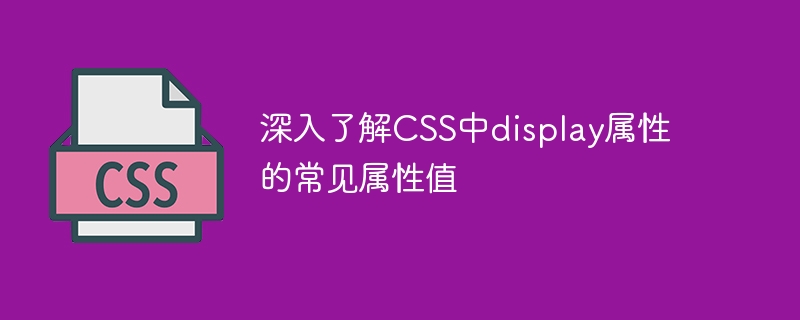 Web Front-end
Web Front-end
 CSS Tutorial
CSS Tutorial
 Learn more about the common attribute values of the display attribute in CSS
Learn more about the common attribute values of the display attribute in CSS
Learn more about the common attribute values of the display attribute in CSS

In-depth understanding of the common attribute values of the display attribute in CSS requires specific code examples
Introduction:
The display attribute of CSS controls how elements are displayed one of the important attributes. It determines how the element is presented in the document, including whether to generate a box, whether to occupy an exclusive line, whether to be visible, etc. This article will introduce in depth the common attribute values of the display attribute, and attach specific code examples to help readers better understand and master the usage of these attribute values.
- block
block is the default value of the display attribute, which causes the element to generate a block-level box and occupy its own line. Common block elements include div, p, h1-h6, etc.
Sample code:
<div style="display: block; background-color: red; width: 200px;">
这是一个块级元素
</div>- inline
inline causes the element to generate an inline box and does not occupy a single line. Common inline elements include span, a, img, etc.
Sample code:
<span style="display: inline; background-color: yellow;">
这是一个行内元素
</span>- inline-block
inline-block causes the element to generate an inline block-level box, which does not occupy an exclusive line, but also Set width and height. Common inline-block elements include input, button, etc.
Sample code:
<input type="text" style="display: inline-block; width: 200px; height: 30px;">
- none
none causes the element not to generate a box, that is, completely hiding the element. Hidden elements will not occupy any space and will not affect the layout of other elements.
Sample code:
<div style="display: none;">
这是一个隐藏的元素
</div>- flex
flex sets the element as a flexible box container, allowing the layout of the items inside the box to be adjusted through the box's properties. Common values for the flex attribute include row, column, row-reverse, column-reverse, etc.
Sample code:
<div style="display: flex; flex-direction: row; justify-content: space-between;">
<div style="width: 100px; height: 100px; background-color: red;"></div>
<div style="width: 100px; height: 100px; background-color: blue;"></div>
<div style="width: 100px; height: 100px; background-color: green;"></div>
</div>Conclusion:
The display attribute is a very useful attribute in CSS, which can control the display mode of elements. Common attribute values are block and inline , inline-block, none and flex, etc. By having an in-depth understanding of these attribute values and combining them with specific code examples, readers will be able to better understand and apply these attribute values and achieve better page layout effects. Hope this article is helpful to readers.
The above is the detailed content of Learn more about the common attribute values of the display attribute in CSS. For more information, please follow other related articles on the PHP Chinese website!

Hot AI Tools

Undresser.AI Undress
AI-powered app for creating realistic nude photos

AI Clothes Remover
Online AI tool for removing clothes from photos.

Undress AI Tool
Undress images for free

Clothoff.io
AI clothes remover

Video Face Swap
Swap faces in any video effortlessly with our completely free AI face swap tool!

Hot Article

Hot Tools

Notepad++7.3.1
Easy-to-use and free code editor

SublimeText3 Chinese version
Chinese version, very easy to use

Zend Studio 13.0.1
Powerful PHP integrated development environment

Dreamweaver CS6
Visual web development tools

SublimeText3 Mac version
God-level code editing software (SublimeText3)

Hot Topics
 1387
1387
 52
52
 Building an Ethereum app using Redwood.js and Fauna
Mar 28, 2025 am 09:18 AM
Building an Ethereum app using Redwood.js and Fauna
Mar 28, 2025 am 09:18 AM
With the recent climb of Bitcoin’s price over 20k $USD, and to it recently breaking 30k, I thought it’s worth taking a deep dive back into creating Ethereum
 Vue 3
Apr 02, 2025 pm 06:32 PM
Vue 3
Apr 02, 2025 pm 06:32 PM
It's out! Congrats to the Vue team for getting it done, I know it was a massive effort and a long time coming. All new docs, as well.
 Can you get valid CSS property values from the browser?
Apr 02, 2025 pm 06:17 PM
Can you get valid CSS property values from the browser?
Apr 02, 2025 pm 06:17 PM
I had someone write in with this very legit question. Lea just blogged about how you can get valid CSS properties themselves from the browser. That's like this.
 A bit on ci/cd
Apr 02, 2025 pm 06:21 PM
A bit on ci/cd
Apr 02, 2025 pm 06:21 PM
I'd say "website" fits better than "mobile app" but I like this framing from Max Lynch:
 Stacked Cards with Sticky Positioning and a Dash of Sass
Apr 03, 2025 am 10:30 AM
Stacked Cards with Sticky Positioning and a Dash of Sass
Apr 03, 2025 am 10:30 AM
The other day, I spotted this particularly lovely bit from Corey Ginnivan’s website where a collection of cards stack on top of one another as you scroll.
 Using Markdown and Localization in the WordPress Block Editor
Apr 02, 2025 am 04:27 AM
Using Markdown and Localization in the WordPress Block Editor
Apr 02, 2025 am 04:27 AM
If we need to show documentation to the user directly in the WordPress editor, what is the best way to do it?
 Comparing Browsers for Responsive Design
Apr 02, 2025 pm 06:25 PM
Comparing Browsers for Responsive Design
Apr 02, 2025 pm 06:25 PM
There are a number of these desktop apps where the goal is showing your site at different dimensions all at the same time. So you can, for example, be writing
 Let's use (X, X, X, X) for talking about specificity
Mar 24, 2025 am 10:37 AM
Let's use (X, X, X, X) for talking about specificity
Mar 24, 2025 am 10:37 AM
I was just chatting with Eric Meyer the other day and I remembered an Eric Meyer story from my formative years. I wrote a blog post about CSS specificity, and



